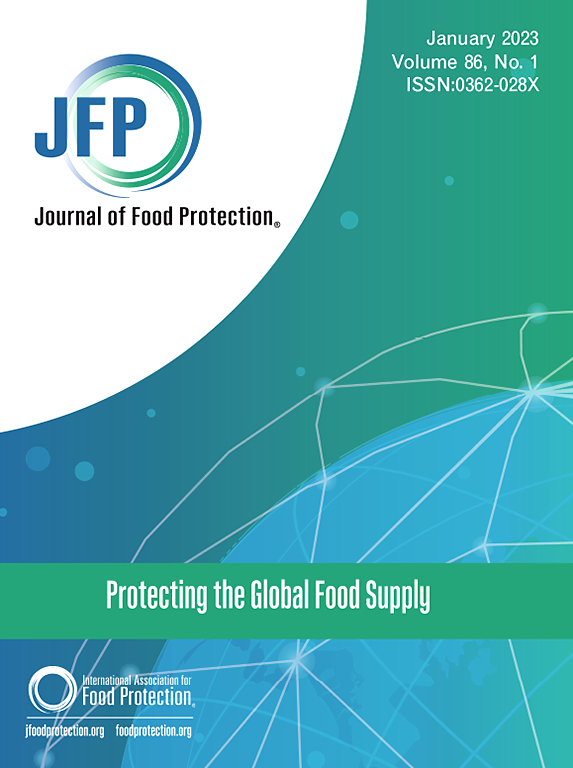USDA Food Recalls for the Period 2012–2023 Compared with FDA Regulated Food Recalls Over the Past Two Decades
IF 2.1
4区 农林科学
Q3 BIOTECHNOLOGY & APPLIED MICROBIOLOGY
引用次数: 0
Abstract
This manuscript evaluates recalls of food products that are regulated by the United States Department of Agriculture (USDA), Food Safety and Inspection Service (FSIS). The FSIS regulates food products made from animals raised on farms including beef, pork, poultry, buffalo, and venison, as well as some egg products and farmed or wild-caught seafood of the order of Siluriformes (catfish). During the 12-year period of 2012–2023, 1,001 food recall incidents occurred representing 205.2 million lbs of recalled product. These recall incidents were classified by the FSIS at 76% as Class I, 20% as Class II, and 4% as Class III. The causes of the recalls were combined for this analysis into three master categories: Product Contaminants, Processing Issues, and Other Reasons. Product Contaminants caused of 68% of the FSIS recalls, Processing Issues added 13%, and Other Reasons contributed 19%. Further evaluation of these recall incidents by product type resulted in Poultry at 29%, Beef at 23%, Mixed Animal meat at 23%, and Pork at 22% of the recall incidents. Evaluation of these recalls by product weight showed Mixed Animal meat at 52%, Poultry at 27%, Beef at 16%, and Pork at 4%. Biological Contamination was a component of the Products Contaminants master category, and 4 bacterial species caused almost 59% of the FSIS recalls by weight. Listeria monocytogenes caused 32%, Shiga toxin-producing E. coli (STEC) caused 12%, Salmonella serovars caused 9%, and Bacillus cereus caused 0.5% of these recalls by weight. These FSIS food recalls were compared to the FDA Food & Beverage recalls from a recent publication. Listeria was the common cause of the highest percentage for the FDA recalled by incidents and FSIS recalls by weight. Most of the food recalls were caused by human error. Developing a strong Food Safety Culture along with strong cleanup and sanitation procedures is imperative to minimizing and preventing food recalls.
2012-2023年美国农业部食品召回与过去二十年FDA监管的食品召回的比较
本文评估了由美国农业部(USDA)、食品安全检验局(FSIS)监管的食品召回。FSIS监管由农场饲养的动物制成的食品,包括牛肉、猪肉、家禽、水牛和鹿肉,以及一些蛋制品和养殖或野生捕获的鲶鱼目海鲜。在2012-2023年的12年期间,发生了1001起食品召回事件,召回的产品达2.052亿磅。这些召回事件被FSIS分类为76%为I类,20%为II类,4%为III类。本次分析将召回的原因分为三大类:产品污染物、加工问题和其他原因。产品污染物占FSIS召回的68%,加工问题占13%,其他原因占19%。根据产品类型对这些召回事件进行进一步评估,发现召回事件中家禽占29%,牛肉占23%,混合动物肉占23%,猪肉占22%。根据产品重量对这些召回进行的评估显示,混合动物肉占52%,家禽占27%,牛肉占16%,猪肉占4%。生物污染是产品污染物主类别的一个组成部分,4种细菌造成了几乎59%的FSIS召回重量。单增李斯特菌引起32%的召回,产志贺毒素大肠杆菌(STEC)引起12%的召回,血清型沙门氏菌引起9%的召回,蜡样芽孢杆菌引起0.5%的召回。FSIS的食品召回与FDA的食品召回进行了比较。饮料召回从最近的出版物。李斯特菌是FDA召回事件和FSIS召回重量百分比最高的常见原因。大多数食品召回都是人为失误造成的。发展强有力的食品安全文化,以及强有力的清洁和卫生程序,是减少和防止食品召回的必要条件。
本文章由计算机程序翻译,如有差异,请以英文原文为准。
求助全文
约1分钟内获得全文
求助全文
来源期刊

Journal of food protection
工程技术-生物工程与应用微生物
CiteScore
4.20
自引率
5.00%
发文量
296
审稿时长
2.5 months
期刊介绍:
The Journal of Food Protection® (JFP) is an international, monthly scientific journal in the English language published by the International Association for Food Protection (IAFP). JFP publishes research and review articles on all aspects of food protection and safety. Major emphases of JFP are placed on studies dealing with:
Tracking, detecting (including traditional, molecular, and real-time), inactivating, and controlling food-related hazards, including microorganisms (including antibiotic resistance), microbial (mycotoxins, seafood toxins) and non-microbial toxins (heavy metals, pesticides, veterinary drug residues, migrants from food packaging, and processing contaminants), allergens and pests (insects, rodents) in human food, pet food and animal feed throughout the food chain;
Microbiological food quality and traditional/novel methods to assay microbiological food quality;
Prevention of food-related hazards and food spoilage through food preservatives and thermal/non-thermal processes, including process validation;
Food fermentations and food-related probiotics;
Safe food handling practices during pre-harvest, harvest, post-harvest, distribution and consumption, including food safety education for retailers, foodservice, and consumers;
Risk assessments for food-related hazards;
Economic impact of food-related hazards, foodborne illness, food loss, food spoilage, and adulterated foods;
Food fraud, food authentication, food defense, and foodborne disease outbreak investigations.
 求助内容:
求助内容: 应助结果提醒方式:
应助结果提醒方式:


